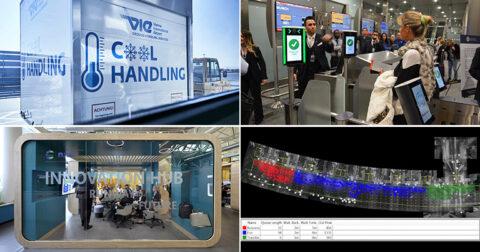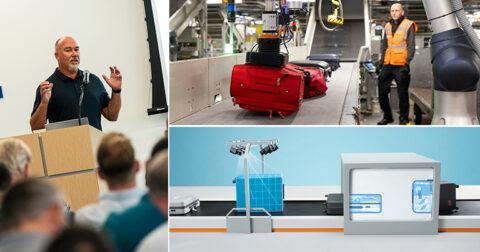The benefits provided by Private Wireless Networks (PWNs) are increasingly clear, including improved network security and enhanced operational efficiency through superior coverage. Indeed, PWNs are vital for those airports and their partners exploring technologies such as the Internet of Things and autonomous vehicles. In this deep-dive article, Eduardo Valencia, Chief Information Officer, Metropolitan Airports Commission; Johnathan Lewis, Division Director Innovation, Miami International Airport; Fritz Oswald, Senior Vice President IT Infrastructure, Fraport; and Samuel Ingalls, Principal, Barich Inc, share their insights into the opportunities and use cases presented by PWNs. This subject will be further explored in-depth in the Private Networks Symposium at FTE Global – the “CES of Aviation” – in Los Angeles, 28-30 October 2024, as well as during the next virtual meeting of the FTE Digital, Innovation & Startup Hub taking place on 11 September 2024.
Register for FTE Global 2024 >> Learn more about the FTE Digital, Innovation & Startup Hub >>MSP’s Private Wireless solution designed for contiguous coverage across the airport property
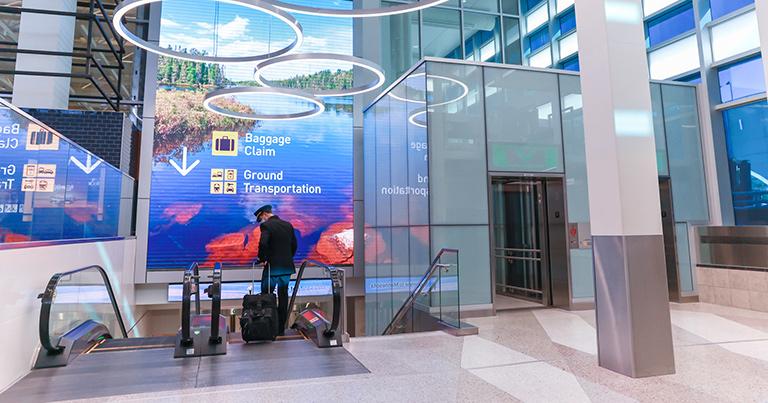
Minneapolis-St. Paul International Airport (MSP) launched its Private Wireless journey in 2022. This involved developing and executing a pilot project to evaluate the abilities and applicability of a Private Wireless system against multiple use cases. “The pilot project successfully proved that a Private Wireless system could support and integrate multiple use cases with backend IT systems, and critically, provide coverage and capacity where it was needed,” explains Eduardo Valencia, Chief Information Officer, Metropolitan Airports Commission (operator of MSP).

MSP subsequently developed an RF (radio frequency) coverage design for the airport outdoor property, and commissioned design and construction work to deploy the fibre, power, and antenna mast infrastructure that would be needed to implement a Private Wireless Network. The airport is currently pursuing a procurement process to select a vendor to supply and operate such a system.
“Private Wireless Networks offer numerous advantages for airports, including tailored coverage, capacity and bandwidth shaping for critical applications such as security cameras and maintenance systems,” says Valencia. “They provide enhanced data control by keeping sensitive information on-premises, improving security through isolation from public cellular networks. They truly bring a fast, secure and low latency wireless option to the connectivity arsenal, which is quite strategic for large campuses like airports.”
The airport has designed its Private Wireless solution for contiguous coverage across the property, including close to terminal buildings where many technologies are needed to support operations. “MSP is positioned and prepared to accommodate these technologies, of which many will need wireless network access with specific performance characteristics that can only be provided through a Private Wireless system,” Valencia shares.
There are, of course, challenges relating to the rollout of Private Wireless Networks in the airport environment. Valencia notes that these include demanding performance requirements for coverage and capacity, and particularly the need to be positioned to support the steadily increasing performance needs of new technologies and systems that are designed for airport operations. “MSP is focused on implementing outdoor wireless services for security cameras, high bandwidth applications for critical airfield maintenance operations, and sensory and control applications,” Valencia adds. “MSP will also provide secure connectivity for mobile digital signage and mobile ticket processing systems for indoor applications.”
MIA strategically leveraging Private Wireless Network to integrate IoT ecosystem into existing infrastructure
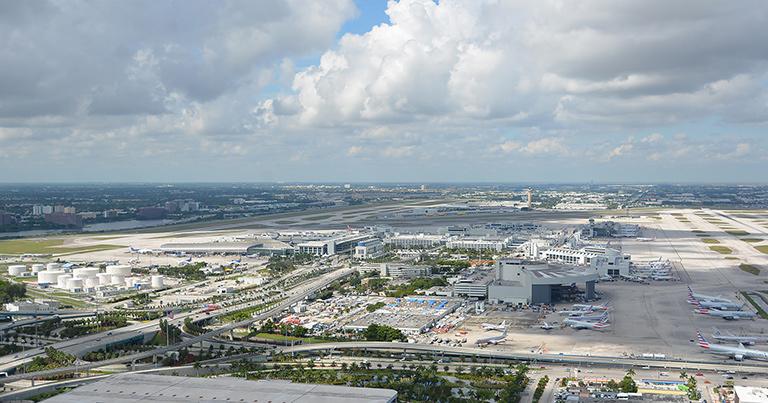
Miami International Airport (MIA) – a Corporate Partner of the FTE Digital, Innovation & Startup Hub – has made significant strides in establishing a Private Wireless Network (PWN) to enhance operational efficiency and the employee experience. “We have successfully deployed a PWN and are installing additional radios to increase capacity and coverage,” explains Johnathan Lewis, Division Director Innovation, Miami International Airport. “The PWN will enable various innovative applications, such as Internet of Things devices for asset tracking, support for mobile kiosks and self-service devices, and high-bandwidth connectivity for video analytics. MIA plans to continue expanding the network’s capabilities and coverage to modernise its operations and support our modernisation initiatives.”

PWNs offer airports numerous benefits, including enhanced reliability, reduced network latency, lower costs, increased control, futureproofing of infrastructure, and the potential to enable new revenue streams and drive innovation. “These networks provide dedicated, isolated connectivity, which reduces cybersecurity-related risks,” says Lewis. “The PWNs also provide increased coverage and capacity. By adopting Private Networks, airports can achieve significant cost efficiencies, especially when supporting high-bandwidth applications and services. Additionally, Private Networks can further reduce costs due to fewer infrastructure requirements.”
MIA is strategically leveraging its Private Wireless Network to integrate an Internet of Things (IoT) ecosystem into its existing infrastructure to enable data-driven decision-making. “IoT insights improve efficiency and optimise resources,” Lewis shares. “Predictive maintenance, driven by IoT sensors, helps identify potential equipment failures early, minimising downtime. Environmental monitoring through IoT sensors provides real-time data on air quality and temperature, contributing to a comfortable and sustainable environment. Event automation triggered by IoT data enables quick responses to unforeseen events, enhancing safety and security. Integrating IoT devices empowers employees with data-driven tools for better productivity, leading to a more informed and proactive workforce.”
Establishing a PWN in an airport involves addressing various technical, operational, and regulatory challenges. From a technical standpoint, it necessitates achieving extensive coverage and capacity in a large, structurally diverse environment, integrating the PWN with existing systems, and ensuring the PWN is secure. “Operationally, the complexity of the deployment, spectrum management, cost considerations, and the need for specialised expertise pose obstacles that airports can overcome with the appropriate knowledge and resources,” says Lewis. “Ensuring compliance with regulations governing spectrum sharing to protect incumbent users adds another layer of complexity. Successful implementation requires subject matter expertise, thorough planning, collaboration, and focusing on the long-term benefits a PWN can offer to improve business outcomes.”
Indeed, Lewis adds that PWNs are vital for airports adopting IoT and autonomous vehicles. “They provide the necessary high-speed, low-latency, and secure connectivity. PWNs ensure reliable, high-bandwidth connections, and enhance security and scalability to support more devices.”
Hear more from Miami International Airport at FTE Global – the “CES of Aviation” taking place in Los Angeles on 28-30 October 2024. Maurice Jenkins, Chief Innovation Officer, Miami International Airport, is moderating the ‘Digital Identity & Biometrics Symposium – Building compelling business cases for a global industry roll-out’.
Explore the full FTE Global 2024 schedule at a glance here >> Register for FTE Global 2024 >>FRA: Private Wireless Networks a game-changer for a lot of operational airport tasks
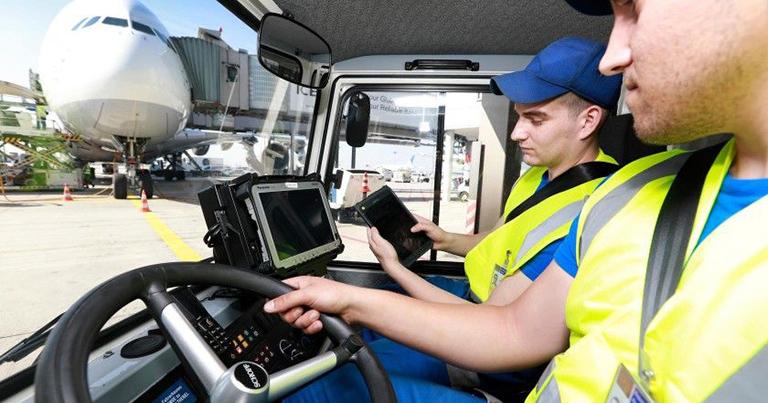
Fraport has successfully licensed and implemented a Private 5G Network at Frankfurt Airport and is in the process of building up more antennas to ensure availability on the whole apron. The network gives the airport an environment in which it can control data and voice communication autonomously. Thanks to the network’s high-bandwidth and low-latency, Fraport will be able to accelerate innovative projects, such as autonomous driving on the apron. The 5G network also enables real-time data transfer, which may be necessary for future applications such as video-based monitoring of airport facilities via robots or drones.

“Besides the benefits of the 5G technology, such as low-latency, higher device density and high-bandwidth, the Private Network gives us the possibility to be independent from public networks,” says Fritz Oswald, Senior Vice President IT Infrastructure, Fraport. “Therefore, we can organise the network to our needs regarding network slicing and enhanced reliability.”
Fraport sees a lot of use cases for the Private 5G Network, with the most interesting being those where there are moving parts with the need for data exchange. “We find these in autonomous vehicles, robots and drone operations,” Oswald explains. “Connecting different devices and being able to analyse sensor and video data in real-time can be a game-changer for a lot of operational airport tasks. Besides that, we are equipping the mobile devices of our operational workforce with 5G connectivity. With that, all needed information, such as instruction videos for technical staff, is just a fingertip away.”
Hear more from Fraport at FTE Global – the “CES of Aviation” taking place in Los Angeles on 28-30 October 2024. Rolf Felkel, Senior Vice President Applications and Partner Management, Fraport, is participating in the ‘FTE AI Symposium’ with a presentation titled ‘What exactly does the AI @ FRA programme look like and what business cases and learnings can be shared from the effort so far?’
Explore the full FTE Global 2024 schedule at a glance here >> Register for FTE Global 2024 >>Barich Inc: Private Wireless Networks are foundational to moving digital transformation from concept to reality
Samuel Ingalls, Principal, Barich Inc, and a Captain of the FTE Digital, Innovation & Startup Hub, is leading the Private Networks Symposium at FTE Global – the “CES of Aviation” taking place in Los Angeles on 28-30 October 2024.

Ingalls emphasises that airports are large geographic areas, with a need for robust connectivity throughout landside and airside. “This connectivity is a key enabler for both existing systems and sensors, as well as facilitating the wave of newly arriving systems – many utilising the Internet of Things in some form or fashion, such as autonomous systems and vehicles. All of these systems and sensors are foundational to moving digital transformation from concept to reality.”
The goal of data-driven decision-making fundamentally requires robust connectivity. Ingalls explains that there are three legs to the connectivity stool: WiFi, Distributed Antenna System (DAS) and Private Wireless. “Each of these has a particular target audience and underlying technology,” he says. “It should be noted that DAS and WiFi infrastructure were both installed at major airports 15-20 years ago – as such, these core systems have evolved significantly and are more than ready for an update. Autonomous systems and vehicles are certainly in focus, as is Artificial Intelligence.”
Private Wireless Networks are applicable across the extended expanse of the geographic footprint that is an airport. “Perhaps some of the best use cases live out at the edge, such as the fence line and roadways, where better sensing should almost certainly mean a safer and more secure environment,” Ingalls shares. “The lack of systems in these important areas is not due to a dearth of need, but rather to a lack of connectivity.”
Noting the challenges relating to the rollout of Private Wireless Networks in the airport environment, Ingalls comments that airports really need to have a very good strategic roadmap for connectivity. WiFi, DAS and Private Wireless each have a role to play and are quickly evolving. “Understanding what play to make in what area, and who/what the target is, will be helpful moving forward into a reality of enhanced business benefit and guest experience,” says Ingalls.
Looking ahead, Ingalls is leading the Private Networks Symposium at FTE Global – the “CES of Aviation” taking place in Los Angeles on 28-30 October 2024. “I really hope to bring added focus to this important conversation to all of the many stakeholders that would derive benefit,” he shares. “The PWN technology is proven, being something that we all use each and every day – and which works stunningly well. The greater understanding goes to the business benefit – the many use cases that stand to be addressed by the informed application of this technology. In short, connectivity in aviation is no longer a ‘nice-to-have’ – it is an imperative. True and sustained digital transformation starts and grows with that robust connectivity.”
Hear more from Samuel Ingalls, Principal, Barich Inc, at FTE Global – the “CES of Aviation” taking place in Los Angeles on 28-30 October 2024. Ingalls is leading the ‘Symposium on establishing and leveraging Private Networks at the airport’ alongside Mike Youngs, Vice President Information Technology, Dallas Fort Worth International Airport. Meanwhile, Ingalls is also moderating the ‘Self-Service Evolution Summit’.
Explore the full FTE Global 2024 schedule at a glance here >> Register for FTE Global 2024 >>Private Networks Symposium to take place at FTE Global – the “CES of Aviation” – in Los Angeles, 28-30 October 2024
Private Wireless Networks will be further explored in-depth in the Private Networks Symposium at FTE Global – the “CES of Aviation” taking place in Los Angeles on 28-30 October 2024. Led by Samuel Ingalls, Principal, Barich Inc, and Mike Youngs, Vice President Information Technology, Dallas Fort Worth International Airport, the Symposium will see experts in the field of Private Networks, and guest speakers, share insights and learnings in an interactive environment.
Explore the full FTE Global 2024 schedule at a glance here >> Register for FTE Global 2024 >>

